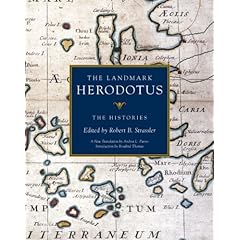
Robert Strassler, the 70-year-old president of Riverside Capital Management Corp., a private investment firm, is a Harvard graduate who describes himself as a historian of the ancient Mediterranean. Back in 1996, he edited "The Landmark Thucydides: A Comprehensive Guide to The Peloponnesian War," that was published by CBS Corp.'s Free Press. This book received excellent reviews and sold over 24,000 copies. It has taken 10 years for a sequel "The Landmark Herodotus" is now available from Pantheon with 20,000 copies in print.
When Wall Street Journal columnist, Jeffrey Trachtenberg asked Strassler why it took so long to write this sequel, Strassler says, "Thucydides is more narrowly focused. He was interested only in military and political history. Herodotus is interested in everything. He wants to know what people wear, what gods they worship, what crops they grow. I needed 11 appendices for Thucydides to provide context, but we have 21 for Herodotus, and we could have done another five to 10."
When asked about the reliability of Herodotus' chronicles, Strassler replies, "There are a lot of questions. He does tend to write about fables, things that aren't real. His job was to tell you what he heard. He's critical, but there are anecdotes where you don't know if he's pulling your leg, or his leg is being pulled. For example, he said he saw a sign on one of the Pyramids. He asked his Egyptian guide about it and says he was told that the sign listed the amount of garlic, leeks and onions consumed by the workmen over the 20 years it took to build the pyramid. Do you think he believed it? But he put it in his book. You can't always be sure. And he wasn't an eyewitness to everything. But this book has survived for 2,500 years, and it offers a huge panorama of his world."
If you wish to learn even more about Herodotus, I would highly recommend an audio course offered through the Teaching Company, Herodotus: Father of History presented by Professor Elizabeth Vandiver of Whitman College.
